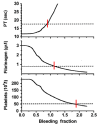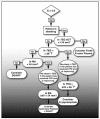The contemporary role of blood products and components used in trauma resuscitation
- PMID: 21106098
- PMCID: PMC3004811
- DOI: 10.1186/1757-7241-18-63
The contemporary role of blood products and components used in trauma resuscitation
Abstract
Introduction: There is renewed interest in blood product use for resuscitation stimulated by recent military experience and growing recognition of the limitations of large-volume crystalloid resuscitation.
Methods: An editorial review of recent reports published by investigators from the United States and Europe is presented. There is little prospective data in this area.
Results: Despite increasing sophistication of trauma care systems, hemorrhage remains the major cause of early death after injury. In patients receiving massive transfusion, defined as 10 or more units of packed red blood cells in the first 24 hours after injury, administration of plasma and platelets in a ratio equivalent to packed red blood cells is becoming more common. There is a clear possibility of time dependent enrollment bias. The early use of multiple types of blood products is stimulated by the recognition of coagulopathy after reinjury which may occur as many as 25% of patients. These patients typically have large-volume tissue injury and are acidotic. Despite early enthusiasm, the value of administration of recombinant factor VIIa is now in question. Another dilemma is monitoring of appropriate component administration to control coagulopathy.
Conclusion: In patients requiring large volumes of blood products or displaying coagulopathy after injury, it appears that early and aggressive administration of blood component therapy may actually reduce the aggregate amount of blood required. If recombinant factor VIIa is given, it should be utilized in the fully resuscitated patient. Thrombelastography is seeing increased application for real-time assessment of coagulation changes after injury and directed replacement of components of the clotting mechanism.
Figures







Similar articles
-
Whole blood use in trauma resuscitation: targeting prehospital transfusion.Curr Opin Anaesthesiol. 2022 Apr 1;35(2):146-149. doi: 10.1097/ACO.0000000000001099. Curr Opin Anaesthesiol. 2022. PMID: 35102044 Review.
-
Postinjury coagulopathy management: goal directed resuscitation via POC thrombelastography.Ann Surg. 2010 Apr;251(4):604-14. doi: 10.1097/SLA.0b013e3181d3599c. Ann Surg. 2010. PMID: 20224372 Review.
-
[Evolution of US military transfusion support for resuscitation of trauma and hemorrhagic shock].Transfus Clin Biol. 2013 May;20(2):225-30. doi: 10.1016/j.tracli.2013.02.003. Epub 2013 Apr 15. Transfus Clin Biol. 2013. PMID: 23597584 Review. French.
-
Damage control resuscitation using blood component therapy in standard doses has a limited effect on coagulopathy during trauma hemorrhage.Intensive Care Med. 2015 Feb;41(2):239-47. doi: 10.1007/s00134-014-3584-1. Epub 2014 Dec 2. Intensive Care Med. 2015. PMID: 25447807
-
Novel concepts for damage control resuscitation in trauma.Curr Opin Crit Care. 2017 Dec;23(6):498-502. doi: 10.1097/MCC.0000000000000455. Curr Opin Crit Care. 2017. PMID: 28953559 Review.
Cited by
-
Recent advances in the medical applications of hemostatic materials.Theranostics. 2023 Jan 1;13(1):161-196. doi: 10.7150/thno.79639. eCollection 2023. Theranostics. 2023. PMID: 36593953 Free PMC article. Review.
-
Unanswered questions in the use of blood component therapy in trauma.Scand J Trauma Resusc Emerg Med. 2011 Jan 17;19:5. doi: 10.1186/1757-7241-19-5. Scand J Trauma Resusc Emerg Med. 2011. PMID: 21241509 Free PMC article.
-
The "coagulation box" and a new hemoglobin-driven algorithm for bleeding control in patients with severe multiple traumas.Arch Trauma Res. 2013 Spring;2(1):3-10. doi: 10.5812/atr.10894. Epub 2013 Jun 1. Arch Trauma Res. 2013. PMID: 24396782 Free PMC article.
-
Experience with uncrossmatched blood refrigerator in emergency department.Trauma Surg Acute Care Open. 2018 Oct 9;3(1):e000184. doi: 10.1136/tsaco-2018-000184. eCollection 2018. Trauma Surg Acute Care Open. 2018. PMID: 30402556 Free PMC article.
-
Haemostatic monitoring during postpartum haemorrhage and implications for management.Br J Anaesth. 2012 Dec;109(6):851-63. doi: 10.1093/bja/aes361. Epub 2012 Oct 16. Br J Anaesth. 2012. PMID: 23075633 Free PMC article. Review.
References
-
- Simmons RL, Collins JA, Heisterkamp CA, Mills DE, Andren R, Phillips LL. Coagulation disorders in combat casualties. I. Acute changes after wounding. II. Effects of massive transfusion. III Post-resuscitative changes. Ann Surg. 1969;169:455–482. doi: 10.1097/00000658-196904000-00001. - DOI - PMC - PubMed
Publication types
MeSH terms
LinkOut - more resources
Full Text Sources
Medical

